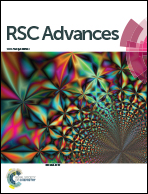Magnetically recoverable mesoporous melamine–formaldehyde nanoparticles as an efficient adsorbent for hexavalent chromium removal†
Abstract
Functional porous nanoparticles have been considered as potential adsorbents for chromium (Cr) removal due to their unique properties such as high surface area, nanosized structure and specific affinity for heavy metal ions. Among these adsorbents, magnetic supports are one of the most efficient adsorbents for their unique advantages of easy separation under external magnetic fields. In this study, magnetic mesoporous melamine–formaldehyde (MMMF) nanoparticles with high surface area (393 m2 g−1), uniform pore sizes (6.9 nm), and relatively high saturation magnetization (4.3 emu per g) have been prepared. These MMMF nanoparticles are highly effective in removing toxic hexavalent chromium (Cr(VI)) from water within 5 to 10 min. More importantly, they can be easily regenerated by a simple basic treatment (0.1 M NaOH) and reused at least five times. The effects of initial Cr(VI) concentration, temperature and pH on the adsorption properties of MMMF are also investigated. The superior adsorption properties of MMMF make them an attractive adsorbent for water quality purification and improvement.


 Please wait while we load your content...
Please wait while we load your content...